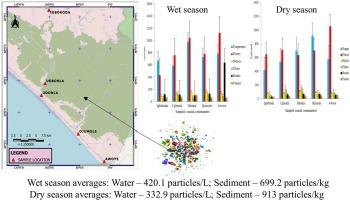Seasonal variation of meso- and micro-plastics in water and sediments of coastal communities in Ondo State, Nigeria
Q1 Environmental Science
Environmental Nanotechnology, Monitoring and Management
Pub Date : 2024-11-20
DOI:10.1016/j.enmm.2024.101027
引用次数: 0
Abstract
Plastic particles (both meso- and micro-plastics) are ubiquitous in the aquatic environment. They exert profound effects on organisms and may potentially enter the human food chain. Seasonal changes in abundance and types of plastic particles are poorly understood. In this study, plastic particles were determined in five communities along the Atlantic coast of Ondo State, Nigeria. A total of fifty (50) composite water and sediment samples were collected from the communities during each of wet (rainy) and dry seasons of year 2022.The plastic particles were recovered from water samples by filtering through 0.45 μm membrane. Those in sediments were recovered by floatation with supersaturated solution of zinc chloride (ZnCl2, density 1.5 g/cm3). Polymer identification of sizable particles was performed with attenuated total reflectance − Fourier transform infrared (ATR-FTIR) spectroscopy. The plastic particles were more in the waters during the wet season (10,503) than in the dry season (8,322). For the sediments, the particles were more in the dry season (22,824) compared to the wet season (17,481). Fibre particles were detected most frequently in both seasons. Blue coloured particles (36 %) were predominant in the water samples during the wet season, while white particles (41 %) occurred most frequently in the dry season. Nine (9) plastic polymer types were identified in the sediments, with low-density polyethylene (LDPE, at 64 %) being the dominant plastic material found. Replacement of single-use LDPE “polybags” with reusable alternatives would reduce plastic pollution in the Nigerian coastal area, which connects with the global marine environment.

尼日利亚翁多州沿海社区水和沉积物中的中型和微型塑料的季节性变化
塑料微粒(包括中型塑料和微型塑料)在水生环境中无处不在。它们对生物产生深远影响,并有可能进入人类食物链。人们对塑料微粒数量和类型的季节性变化知之甚少。本研究测定了尼日利亚翁多州大西洋沿岸五个社区的塑料微粒。在 2022 年的湿季(雨季)和旱季,分别从这些社区收集了五十(50)份水和沉积物复合样本。沉积物中的塑料微粒则通过氯化锌(ZnCl2,密度为 1.5 克/立方厘米)过饱和溶液漂浮回收。用衰减全反射-傅立叶变换红外光谱法(ATR-FTIR)对较大颗粒进行聚合物鉴定。雨季水域中的塑料微粒(10 503 个)多于旱季(8 322 个)。在沉积物中,旱季(22,824 个)的颗粒多于雨季(17,481 个)。在这两个季节中,纤维颗粒的检测频率最高。雨季水样中主要是蓝色颗粒(36%),而旱季则最多是白色颗粒(41%)。在沉积物中发现了九(9)种塑料聚合物,其中低密度聚乙烯(LDPE,占 64%)是最主要的塑料材料。用可重复使用的替代品取代一次性使用的低密度聚乙烯 "聚乙烯袋",将减少尼日利亚沿海地区的塑料污染,因为该地区与全球海洋环境相连。
本文章由计算机程序翻译,如有差异,请以英文原文为准。
求助全文
约1分钟内获得全文
求助全文
来源期刊

Environmental Nanotechnology, Monitoring and Management
Environmental Science-Water Science and Technology
CiteScore
13.00
自引率
0.00%
发文量
132
审稿时长
48 days
期刊介绍:
Environmental Nanotechnology, Monitoring and Management is a journal devoted to the publication of peer reviewed original research on environmental nanotechnologies, monitoring studies and management for water, soil , waste and human health samples. Critical review articles, short communications and scientific policy briefs are also welcome. The journal will include all environmental matrices except air. Nanomaterials were suggested as efficient cost-effective and environmental friendly alternative to existing treatment materials, from the standpoints of both resource conservation and environmental remediation. The journal aims to receive papers in the field of nanotechnology covering; Developments of new nanosorbents for: •Groundwater, drinking water and wastewater treatment •Remediation of contaminated sites •Assessment of novel nanotechnologies including sustainability and life cycle implications Monitoring and Management papers should cover the fields of: •Novel analytical methods applied to environmental and health samples •Fate and transport of pollutants in the environment •Case studies covering environmental monitoring and public health •Water and soil prevention and legislation •Industrial and hazardous waste- legislation, characterisation, management practices, minimization, treatment and disposal •Environmental management and remediation
 求助内容:
求助内容: 应助结果提醒方式:
应助结果提醒方式:


